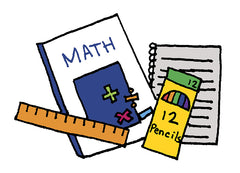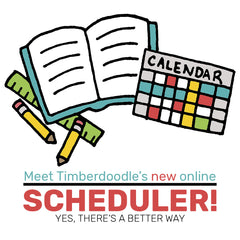You Asked:
How should I educate a 3- & 5-year-old together? Use a Pre-K curriculum and just challenge my older (who’s ready for K curriculum in reading and math) separately?
Our Answer:
What a great question! Have you done our early education placement test with your children yet? Each child is so very different, making it prudent to assess each one's actual skills and find his or her ideal starting point.
But let's say you've done that and have a preschool and kindergarten student by level. The question then becomes whether to teach to the younger, teach to the older, shoot for somewhere in the middle, or have each child do their own curriculum.
It's important to note that there is no one right choice that will work for every situation. All choices are valid options! The idea is to choose the program that best meets the needs of your family.
In many cases, it will be best to have each child do their own work at least for the essentials. If finances are an issue (a concern we totally understand!) then consider backing down from elite kits to complete or basic editions for each child or combining certain subjects. For instance, you could have both kids work through a single STEM or science kit. This tends to be more natural than merely assigning both to the same work across the board. Our free kit customization can work really well in this situation, allowing you to build the perfect assortments for your family.
However, there are a few situations where one of the other options may be more helpful, so let's compare them.
Teaching to the Youngest
Advantages
- Perfect for filling in gaps for the older student
- Can build confidence
- Tailored to the young child
Disadvantages
- The older child may be bored - not the taste you want for school
- In years to come your older child may feel a bit behind his peers
If your older student struggles with fine motor skills, this can be a gentle way to bring them up to speed, particularly if you do as you suggest and add in more advanced reading and math to keep them appropriately challenged there.
Teaching to the Oldest
Advantages
- Your older student's learning will likely take off
- Your younger student may find that trying to stay up with the older sibling motivates great strides in his own learning
Disadvantages
- May overwhelm your younger student, leaving him frustrated at trying to keep up or bored if he gives up.
This is perfect if your younger child is particularly bright, has exceptionally fine motor skills, or thrives on doing the same thing as your older child. Since you will need an extra set of workbooks though, consider substituting the preschool edition of the same subject where possible. (E.G., instead of getting two sets of Math-U-See Primer workbooks, you might consider the preschool Mathematical Reasoning for your preschooler.)
Shooting for the Middle
Advantages
- Ideal for an older student who needs to fill in educational gaps or build confidence, and a younger student who needs to be challenged
Disadvantages
- The older student may be bored if they already know the information
- The younger student may be frustrated trying to keep up
- Some older siblings will be deeply offended that a younger sibling is doing precisely the same work he is. There is a balance here - his pride shouldn't rule the day, but we also want to be careful we don't demoralize him if we can help it.
Particularly in these early years, this can be an excellent way to get started. You only have one kit to familiarize yourself with, and you'll simply pace your older child through the kit in one year while your younger student takes two years.
Each Child Does Their Own Work
Advantages
- Perfectly tailored to both students
Disadvantages
- It's likely to be more expensive
- Can feel like more work to teach - at least initially
This is by far our first choice so that you're tailoring as much of their learning as possible to their specific needs. Not that we'd never combine a subject (we definitely do!) but in general, starting with individual kits and removing duplicates allows for a much more custom approach and maximizes each child's learning.
Still Not Sure?
One suggestion that may help you in making your choice would be to write out a chart with the names of your children on one side, and the year across the top. Then look at how each of your options would work over the next few years, moving on up through the grade levels starting with the kit you choose for this year.
|
|
2019 |
2020 |
2021 |
2022 |
2023 |
2024 |
2025 |
2026 |
|
Big Sister |
K |
1 |
2 |
3 |
4 |
5 |
6 |
7 |
|
Brother |
Preschool |
PreK |
K |
1 |
2 |
3 |
4 |
5 |
|
Baby |
0 |
0 |
Preschool |
preK |
K |
1 |
2 |
3 |
 Skip to content
Skip to content





